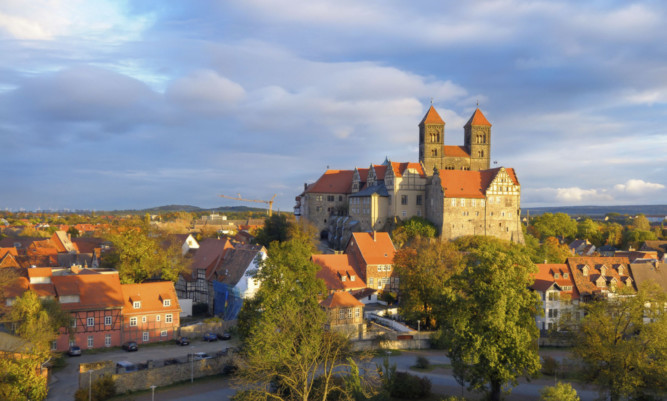
Saxony’s mountain magic is a must-see destination.
If any one trip exceeded my expectations this year it was to the beautiful Harz Mountains region of Germany.
This part of Saxony straddles the former East and West Germany (where a large part of the British Army used to be stationed) and is an absolute gem.
It’s a little-known area for most Brits, but it is well worth getting to know as it’s fairytale Germany at its best.
Fly to Hannover (flybe fly from Manchester and Birmingham, with connections from Scotland), hop in a hire car and get yourself to Goslar, the chocolate-box beautiful regional capital, in just over an hour.
The half-timber houses, castles, historic mines and the backdrop of spectacular mountains make this a fascinating area to tour.
UNESCO have awarded World Heritage status to no less than three sites in this small region and I managed to get round them all.
My tour ran like this (and I would thoroughly recommend it, as it’s a great itinerary): Goslar Eisleben Quedlinburg, one of the most amazing places in Europe, Hildesheim and Hannover.
Goslar is a delightful town with more than 1,000 years of history.
For centuries it was the favoured seat of government in northern Germany and a centre of Christianity.
The spires of the 47 churches, chapels and monasteries meant it was often referred to as the “Rome of the North”.
The narrow, cobblestoned streets of the Old Town are charming but the highlight is a visit to The Imperial Palace, built between 1040 and 1050.
On the outskirts of Goslar you find the Mines of Rammelsberg. Historically, it was a hugely significant source of copper, lead and zinc ore.
The mine closed in 1988 but you can take a guided tour. Do remember to take sturdy shoes and a jacket I was freezing!
Energy for the mine was supplied by the Upper Harz water management system, a masterpiece of early mining and engineering artistry, consisting of 107 historical ponds, 310 kilometres of ditches and 31 km of waterways.
It’s one of the largest pre-industrial power supply facilities in the world. This part of the World Heritage site can be explored on foot along a network of waterside trails.
In Eisleben I saw where Martin Luther was born in 1483 and died in 1546. The church where he preached is locked but tourist info staff can let you in for a look around.
The highlight of the trip for me was the medieval Old Town of Quedlinburg, where Henry l became the first King of the Holy Roman Empire of the German Nation.
Once a member of the Hanseatic League, Quedlinburg is a delightful, medieval town, dating back more than a 1000 years.
Winding alleys with ancient cobbles, spacious squares, fabulous half-timbered houses, it is one of the prettiest towns I have ever seen.
The town is dominated by the castle and the Romanesque St Servatius church. The Saxon duke Heinrich 1 was buried here in 936 AD. His widow, Queen Mathilde, founded a lady’s secular convent in the same year.
Today the rooms of the former convent accommodate the castle museum. There are 2,069 picturesque half-timbered houses the most you’ll find anywhere in the world.
Reluctantly I left this Hansel & Gretal town and headed for Hildesheim where there are two outstanding examples of early Romanesque architecture St Michael’s Church and the Cathedral of St Mary, both UNESCO World Heritage sights.
Some 90% of this city was bombed during the Second World War but with typical German determination it has been rebuilt over the past decades and the market square once again has beautiful buildings.
It’s half an hour’s drive from there to Hannover, the capital of the State of Lower Saxony.
Here you can stroll through the Royal Gardens of Herrenhausen, enjoy world class shopping in the attractive pedestrianised streets, and enjoy a walk round the Maschsee Lake.
In the gorgeous Old Town you find historic timber-framed buildings, the imposing Market Church and the Old Town Hall.
I was lucky enough to be visiting when the Small Festival in the Big Park was on in the stunning Royal gardens of Herrenhausen.
Acts from all over the world perform at the festival, acrobats, comedians, cabaret, musicians, you name it 130 artists on more than 30 stages, and you can stroll from act to act.
Tickets to the three-week event are like gold dust and locals even buy hotel packages which include packages, just so they can get in! At 28 euros it’s a bargain.
It’s reason enough to time your visit to this beautiful part of Europe around it.
For more on the Harz region, known as Germany’s hidden treasure, visit issuu.com/harzinfo/docs/harz-english.
The town of Quedlinburg, a UNESCO World Heritage site has a website at quedlinburg.de/en.
Flybe operates flights from Aberdeen Airport to Hannover Airport seven times a week, with fares available from £67.00 each way including taxes and charges. Book at flybe.com.

Enjoy the convenience of having The Sunday Post delivered as a digital ePaper straight to your smartphone, tablet or computer.
Subscribe for only £5.49 a month and enjoy all the benefits of the printed paper as a digital replica.
Subscribe